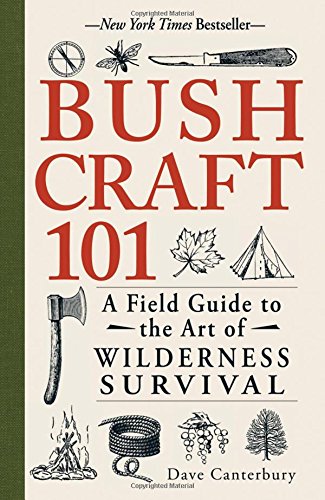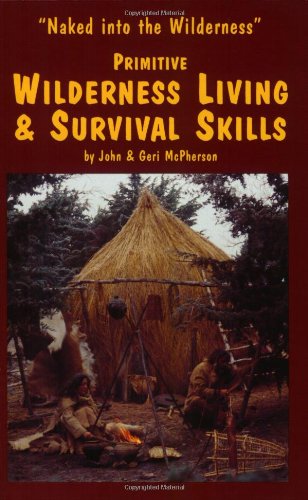While there are many different forms of survival, being able to survive in the wilderness is a crucial skill, with a lot of books written on the subject.
This can make it difficult to choose the best wilderness survival books, so it is important to evaluate what kind of information you are looking for.
Books can be a great resource to develop your survival skills, and when it comes to surviving in the wild, wilderness survival books are widely accessible.
However, they can vastly differ in quality and style. That’s why we’ve compiled our list of the best wilderness survival books to help you make the best decision.
One of the best reasons to invest in wilderness survival books is their longevity; you can refer to them as many times as you need to, and even pass them down to other keen survivalists in the future.
Take a look at our picks for the best books about survival in the wilderness, and we hope they can be useful to you in developing your survival skills.
Bushcraft First Aid: A Field Guide to Wilderness Emergency Care
This is the second book on our list from survival expert Dave Canterbury and is co-written with outdoor survival instructor Jason Hunt. However, this book is focused solely on first aid advice, rather than more generalized wilderness survival techniques.
Perhaps one of the most important skills you can have when learning wilderness survival is first aid. If you are faced with an emergency situation in the middle of the wilderness, getting access to a hospital is not the most straightforward task. That’s why this book is useful for survivalists of all ability levels, as keeping this book to hand could potentially save a life.
While it may seem like a standard first-aid manual on the surface, the book digs deeper into first-aid techniques to help you specifically in the wilderness. It explains how to treat different conditions through the use of plants, and how to make bandages and dressings only using the tools you have around you.
If you do feel quite overwhelmed at the prospect of learning lots of first-aid techniques, the book doesn’t use complex medical terminology. Instead, the authors write simplistically, making it accessible to people without medical knowledge.
Although the book has diagrams and pictures throughout, some readers have found that there aren’t enough images, which can cause difficulty in a survival situation where you need answers quickly.
Despite only being tailored around first-aid advice for the wilderness, the information itself is necessary knowledge, so it is worth considering this as a must-have in your wilderness survival book collection.
Read the full post_title; ?> review
Pros
- Co-authored by survival experts Dave Canterbury and Jason Hunt
- Ideal for beginners and advanced survivalists
- Doesn't overcomplicate with complex medical terms
Cons
- Arguably not enough images which can be inconvenient
Ray Mears' Essential Bushcraft
Written by leading survival expert Ray Mears, even the book itself is suitable for surviving in the wilderness, as it’s a compact size and has a waterproof cover. It doesn’t get much more survivalist than that!
In this book, you will find advice on a wide range of wilderness-specific survival skills, including building fires, building shelter, how to tie different knots, and how to keep warm. This advice is featured alongside colorful pictures and clear illustrations, so you can get the full idea of how to execute a technique properly.
In addition to the advice in the book, Mears’s enthusiasm for wilderness survival comes through clearly in his writing. This makes it a great choice if you are looking for a dash of inspiration alongside high-quality tips and tricks.
Although the book features a lot of techniques and advice, some customers have described it as being too generalized to be called a ‘bushcraft’ survival book. It is worth considering this as a potential drawback, as the book may tell you information you are already aware of if you own more generalized survival books.
It also contains a lot of essential beginners’ advice, and if you are already knowledgeable about necessary survival skills, you may feel like this book is too simplistic for you.
Read the full post_title; ?> review
Pros
- Written by leading survival expert Ray Mears
- Compact and portable, with a waterproof cover
- Great option for beginners, as it features essential survival advice
- Clear illustrations throughout
Cons
- May read as more generalized survival advice, rather than specific to the wilderness
- Possibly too simplistic for advanced survivalists
Bushcraft: Outdoor Skills and Wilderness Survival
If you are looking for a wilderness survival book written by a highly respected expert in the field, then look no further than ‘Bushcraft: Outdoor Skills and Wilderness Survival.’ Author Mors Kochanski is a renowned bushcraft and wilderness survival instructor, with followers across the globe. You can feel assured knowing that this book has advice from a legendary survival expert.
As a budget-friendly option, this book contains a whole host of information, with clear instructions and diagrams throughout, meaning you get a lot of detail for your money. The book is a suitable option for beginners, as it provides basic advice on topics such as lighting fires, chopping wood, and creating shelter. These are all key skills that any survivalist will need to master, so seeing the information written down may help you apply it in greater detail in reality.
Unlike many wilderness survival books, this book does not focus too heavily on tactics, with the emphasis instead being on true knowledge taken from experience of being in the outdoors. If you are more interested in all of the components to living outdoors, as opposed to crazy tactics, this book is a treasure chest of expert knowledge.
Despite being written by a survival expert, the book is arguably only suitable for beginners or those looking for basic skills. If you are more advanced already, this book may not provide you with enough information to gain any new skills.
Read the full post_title; ?> review
Pros
- Written by legendary survival expert Mors Kochanski
- Great for beginners, with lots of advice on basic skills
- Budget-friendly
- Lots of diagrams throughout
Cons
- 304 pages may be too bulky for a survival backpack
- Not very useful for more advanced survivalists
Bushcraft 101: A Field Guide to the Art of Wilderness Survival
As described in the title, survivalist expert Dave Canterbury explores wilderness survival as an ‘art.’ He covers a variety of topics that help you to not only develop your skills, but that also explore how your experience in the outdoors can be maximized.
While not centered around a specific wilderness survival topic, this book goes into detail about what Canterbury considers to be the most crucial survival skills. These include sections on how to build resources from your surroundings, to collecting and cooking food. Despite there being a lot of areas to cover, the book is in-depth and guides you along the way.
The more generalized style of this book makes it a useful option for beginners. It follows the ‘5cs’ of Survivability – cutting tools, covering, combustion devices, containers, and cordages. If you are entirely new to wilderness survival techniques, then this book will give you an all-round look into both the techniques and the fun of being in the wilderness.
However, despite being a good beginners’ choice, it is worth noting the lack of illustrations in the book. You may find this is inconvenient if you were planning on carrying the book as a handy resource during an expedition.
Some readers have also found that Canterbury can often talk more about the science and history of a technique, rather than giving detailed instructions on how to perform them. This may be inspiring and interesting to keen wilderness survivalists, but it may not be the most useful for quick and easy access to information.
Read the full post_title; ?> review
Pros
- Budget-friendly
- Advice is easy to follow
- Useful for beginners with its basic wilderness skills
- New York Times (Sports & Travel) bestseller
Cons
- Lack of illustrations
- Information, at times, is oversimplified
Primitive Wilderness Living & Survival Skills: Naked into the Wilderness
If your area of interest around wilderness survival is primitive living, then this book could be of use to you.
Written by true primitivists John and Geri McPherson (often known in the survival community as ‘Prairie Wolf’), this book contains practical advice on how to survive with little to no resources. While it may seem more of an entertaining idea than useful for reality, primitive survival skills can come in handy when you least expect it.
Unique from other wilderness survival books, this book focuses on using ancient skills to help you stay alive. This includes, for example, advice on using a bow and arrow to hunt for meat, and how to use sticks and stones as tools. Although this might seem far-fetched, if this type of survival is of interest to you, then the book contains a lot of detailed information on the subject. It also includes over 700 pictures and diagrams, so you are never without a point of reference.
However, some readers have noted that the techniques aren’t entirely ‘primitive.’ They can sometimes require items that you won’t find easily in the wilderness, such as a refrigerator. This is worth bearing in mind, as you may not be able to quickly adapt all of the advice to real primitive survival.
Another potential issue with the book is its publication date. Although it focuses on primitive, ancient techniques that shouldn’t require technology, the book was published in 1993, so there has possibly been a lot more research into primitive survival since that time.
Read the full post_title; ?> review
Pros
- Written by primitive survival experts John and Geri McPherson
- Explores ancient wilderness survival techniques, such as the use of bow and arrows
- More than 700 pictures and diagrams
- A unique area of wilderness survival that is not often explored in other books
Cons
- Some of the techniques can't be applied to real-life as they require unattainable items
- Published in 1993 so information may not be entirely up to date
- Not very lightweight if you want to carry it with you
Find an Area of Interest
Wilderness survival is not simply black and white. There are many different components of this area of survival.
When choosing the best wilderness survival book for you, consider what aspects of wilderness survival you would like to focus on.
Maybe your interest lies with natural medicine, or perhaps you’d like to develop your fire-starting skills. Whatever your concerns may be, there will be a specific survival book for you.
With this in mind, it is worth deciding whether a more generalized survival book, that covers a vast number of topics, would be suitable for you.
These books can, of course, be incredibly useful. However, niche survival books with a specific focus can cover certain topics in more detail, which you may find beneficial.
Practical Ability Level
You may want to choose the most detailed and advanced wilderness survival book out there, but bear in mind your own practical ability level before making a purchase.
If you have never stepped foot in a wilderness survival situation, and feel completely clueless about bushcraft, then you may be best avoiding in-depth books with lots of survival terminology included.
Although you may understand the information, practically applying it to a real situation can be a lot different. By choosing a book suitable to your ability level, it will make applying your skills seem less daunting.
Practicality vs Personal Anecdotes
Wilderness survival books are not the same as a standard novel or non-fiction book. Each author will use their own style to get their message across, but this is important to note when considering which book will be best for you.
If you find that you want convenient and easy access to instructional methods, then books with diagrams and descriptions may be the appropriate choice for you.
However, if your inspiration to be a top survivalist comes from the wisdom of experts, then you might prefer a book with more personal stories and anecdotes instead.
It’s unlikely that you’ll come across a survival book with no illustrations at all, but text-heavy books can be a great option, especially if you need motivation from experienced survivalists.
Portability
One feature that can be overlooked is the size of your chosen book.
Remember, you are planning on surviving in the wilderness, potentially for days on end. Your chosen book may have easy-to-read diagrams for quick access, but if it is too big to conveniently fit in your survival backpack, then it will be of no use to you.
It could be worth considering whether the book is available as an e-Book, if you are a Kindle owner. Although it may be risky to carry this around, it can be more portable and survival backpack friendly in terms of size.
Look for Trusted Reviews and a Respected Author
We hope our review of the best wilderness survival books helps you make your decision. However, if you do read other reviews, then consider their reliability.
If the books are reviewed by experts in the field, then you are better able to assess their strengths and weaknesses.
Another area to look at would be the author’s popularity. While lesser-known authors can write excellent books, a bestselling writer might be better equipped to explain something as niche as wilderness survival.
Even if they are not making bestseller lists, check out author reviews to see whether they are a respectable writer. They are usually a good indicator of how useful a book will be.
Publication Date
Wilderness survival has greatly developed over time, with new ideas and technology continually being implemented. That’s why you should be mindful of the publication date of wilderness survival books.
Ideally, a more recently published book will work best, as it will contain more up-to-date knowledge and incorporate modern technology into its instructions.
However, some older books will have been re-published and updated, so they are not to be completely discounted.
Our Pick
Recap
For an all-round useful and interesting wilderness survival book, my choice would be Ray Mears’s Essential Bushcraft.
Even though it provides general survival advice for the wilderness, this book is both fun to read and easy to digest.
Not only will you be able to apply the advice to real-life situations, but you will feel inspired to get out there and start exploring the wilderness in the first place.
While books aren’t likely to be the first thing you reach for in a survival situation, by choosing the best books about living in the wilderness, you can increase your chances of a safe experience.
The depth of knowledge found in books is often unmatched by online articles and videos, and you are never without advice if you carry one of the best wilderness survival books along with you.
Using your memory and your smartphone may be of benefit to you, but when those things don’t work, a book can potentially be the key to survival.
Share the Love
If you found this post useful, please let others know about it by sharing it.




























